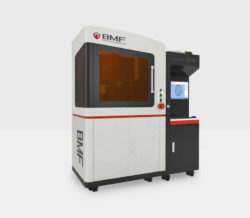BMF Introduces microArch Microscale 3D Printer
The next-gen printer combines high resolution with accuracy, precision and speed for prototyping through short-run production.
October 26, 2021
Boston Micro Fabrication (BMF) unveiled the microArch S230, the latest addition to its roster of industrial-grade micro-precision 3D printers. This next-generation version of BMF’s highest resolution system is designed for applications that require ultra-high resolution prints (down to 2μm) with accuracy, precision and speed.

The microArch S230 printer is built upon BMF’s Projection Micro Stereolithography (PµSL) technology, a technique that allows for rapid photopolymerization of an entire layer of liquid polymer using a flash of UV light at micro-scale resolution, but with a larger build volume (50x50x50 mm) and up to five times faster prints than previous models in the 2μm series.
Additional key features of the microArch S230 include active layer leveling, automated laser calibration and the capacity to handle higher molecular weight materials with viscosities of up to 20,000 Cp, resulting in the production of stronger functional parts, the company says. The printer is compatible with a portfolio of engineering and ceramic resins suitable for end-use parts, including three new materials being announced with the new launch:
- AL (Alumina) Ceramic—A biocompatible and chemical-resistant ceramic resin for high temperature, high strength and high stiffness applications;
- HT 200—A high-temperature and high-strength resin that can be soldered, and designed for end-use in electrical connectors and electrical components;
- MT (Magnesium Titanate) Ceramic—The combination of high dielectric constant and low dielectric loss make MT Ceramic suitable for millimeter wave applications.
“As a current BMF customer, we’ve been thrilled with the performance of our microArch S130 to support our work in micro-printing ceramics—providing the resolution, accuracy and precision necessary for our parts. As the first customer of the new microArch S230, the next generation 2µm system, we are excited to utilize the enhancements of the platform to increase our part capacity with the larger build volume and speed up our printing times. We are looking forward to continuing to work with the BMF team and their line of micro-precision 3D printers to support our micro part needs,” says Toby Schaedler, manager, Architected Materials and Structures Department at HRL Laboratories.
“The miniaturization trend continues to dominate nearly every industry, but as parts get smaller, they become harder to design, more expensive to manufacture, and generally more complicated to put into production. Not to mention, technological barriers had previously made additive manufacturing out-of-reach for most use cases requiring small parts,” says John Kawola, CEO of BMF. “We changed that notion and brought 3D printing to industries that once deemed it impossible, and this new addition to our portfolio—the most advanced of our highest-resolution printers yet —will open even more doors for new applications on the smallest scale.”
Sources: Press materials received from the company and additional information gleaned from the company’s website.
More Boston Micro Fabrication Coverage

Subscribe to our FREE magazine, FREE email newsletters or both!
About the Author
DE’s editors contribute news and new product announcements to Digital Engineering.
Press releases may be sent to them via [email protected].







